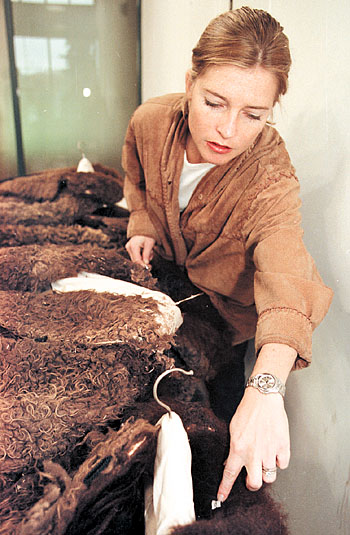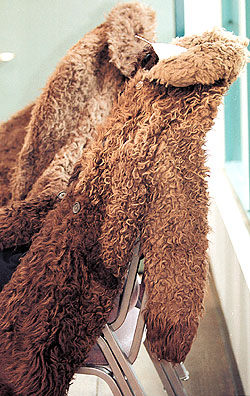|
|
Hart Buffalo Coats Saved From Infestation
[SEE ALSO: Hart's rug collection taken to the cleaners, 10-17-2001]
Amy Rush of the Los Angeles County Museum of Natural History's anthropology department cleans frass from buffalo coats in the William S. Hart Museum collection. Photo by Dana Bowler/For The SignalBy Margie Anne Clark
Signal Staff WriterMonday, February 26, 2001
dozen furry buffalo coats from the Civil War era came out the closet of the William S. Hart Mansion for an emergency cleaning Saturday, with the help of visiting staff from the Los Angeles County Museum of Natural History.
A
Local volunteers from the community lent a hand as well during morning and afternoon shifts inside the newly built Hart Hall on the grounds of William S. Hart Park in Newhall. The coats are a part of the permanent collection of Hart memorabilia, which are displayed on a rotating basis in the mansion throughout the year.
During a routine walk-through of the mansion in January, Hart Hall Administrator, Janis Ashley, noticed that some uninvited guests had found a home in the fragile collection of coats. The discovery of an infestation of moths prompted Ashley to call the staff at the Los Angeles County Museum to come and make an assessment of the situation.
"We had a major infestation problem and we didn't want the moths to migrate into the Navajo wool rugs," Ashley said.
Ashley explained that the Hart museum is currently operating without a full-time curator, due to budget cuts in the late 1980s. The maintenance of the museum is the responsibility of the Los Angeles County Museum. The county staff is responsible for properly assessing the situation, while determining the best course of action for certain situations. Ashley enlisted the help of Beth Wirling, collection manager for the history department of the Los Angeles County Museum to help deal with the problem.
"This is a fairly easy situation to deal with, because unfortunately, pest infestation is something we deal with all of the time," Wirling said. While the task of ridding moths and other pests is a fairly routine procedure, Wirling explained that it is a time-consuming process none-the-less.
"The standard conservation procedure if at all possible, is to avoid the use of any kind of chemicals," Wirling said. "Freezing actually works very well to kill off the larva and the eggs.
"So the plan is to clean everything, and then the volunteers will be bagging the coats up in standard plastic garbage bags. Then we'll put them in the freezer for 48 hours and then zap them again in the freezer for another 48 hours."
Ashley explained that it could take several weeks to complete the project. The coats will be placed in a freezer, which is stored in the ranch house located at William S. Hart Park. Because the freezer is of a standard size, only two or three coats may be placed in it at a time.
Before the coats can be placed in the freezer, the delicate process of brushing and vacuuming the coats must be carefully attended to. Staff members from the museum brought their own artillery of specially designed textile vacuums. The vacuums gently draw unwanted debris from the coats. Natural bristle brushes were also used to clean away a variety of waste material generated by the moths. After a few brief instructions, the volunteers went straight to work, as they began the tedious task of cleaning each coat.
In addition to Wirling, the volunteers received expert advice and help from Lisa Escovedo and Brent Riggs, collection managers from the history department. "Also visiting the museum from the county's anthropology department were, Chris Coleman and Amy Rush. Volunteers and staff worked side by side throughout the day. Ashley was impressed the response of the county and the community.
"It's great to be working with people who have a passion for this type of work. They love doing what they're doing," Ashley said.
Riggs agreed. "It's great to see community members involved with preserving the coats for future generations to come," he said.
Hart acquired the coats to add authenticity to his films. Photo by Dana Bowler/For The Signal
The coats were originally purchased by western screen legend, William S. Hart while he was still living in the mansion. "Our theory is that he purchased them at the Army Surplus store and he probably used them for his films," Wirling said. "Buffalo coats were standard issue by the U.S. Army, especially after the Civil war. If you were making authentic westerns, you would want to use buffalo coats, because this is what they would have been wearing. This was common wear during that time, and this is why the buffalo population was nearly wiped out. After they went out of fashion, and the buffalo almost died off, the coats ended up in Army-Navy surplus stores and that's where Hart must have bought these for the extras in his films."
While volunteers on one side of the room were busy cleaning the historic coats, volunteers on the other side of the room were busy creating specially designed acid-free boxes that will be used as permanent storage for the coats. The coats will be stuffed and covered with acid free tissue in order to minimize the deterioration of the coats.
"Instead of hanging them up in the closet the way they have been, we're going to put them in acid free boxes," Wirling said. "There are two reasons for that; first the weight of the coats are so heavy and so large, that the seams are being strained, causing tearing." She explained that each coat weighs between 35 and 40 pounds. "This will also help monitor frass, which is a combination of bug waste, bug carcasses, bug wings and the like," said Wirling.
She explained that frass can be seen on a white background, but is difficult to see on the brown wooden floors of the closets.
"Sooner or later the moths will get back in there, so were just trying to make it a little bit more difficult for them to return," Wirling said. "Storing the coats in boxes will also save wear and tear on the coats."
Volunteers Elmer and Delmer Neilson, enjoyed lending a helping hand to a good cause. The 82 year-old twins recalled the last time they saw a buffalo coat.
"About 75 years ago, while we were living in Kansas, a man dressed up like Santa Claus paid a visit to our school and he was wearing a buffalo coat that looked very similar to the ones we're seeing here today," Delmer Neilson said. "It's important to preserve these treasures for our children."For more information about upcoming events at Hart Hall and the William S. Hart Museum in Newhall or to volunteer, call 254-4584.
©2001, THE SIGNAL · USED BY PERMISSION · ALL RIGHTS RESERVED.
The site owner makes no assertions as to ownership of any original copyrights to digitized images. However, these images are intended for Personal or Research use only. Any other kind of use, including but not limited to commercial or scholarly publication in any medium or format, public exhibition, or use online or in a web site, may be subject to additional restrictions including but not limited to the copyrights held by parties other than the site owner. USERS ARE SOLELY RESPONSIBLE for determining the existence of such rights and for obtaining any permissions and/or paying associated fees necessary for the proposed use.

